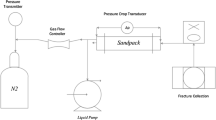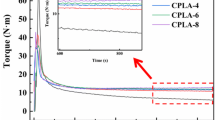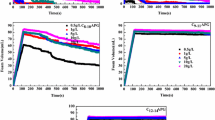Abstract
Hydrophobically modified polyacrylamide (HMPAM), as a foam stabilizer, was prepared with a cationic surfomer, acrylamide and acrylic acid by free-radical polymerization in aqueous solution. The actions of HMPAM on foam stability have been investigated with the Waring blender method. The results showed the foam containing HMPAM was stabler than that contained polyacrylamide. Moreover, a linear relationship between the logarithm of the half decay time and polymer concentration was observed, and the slope reflects the polymer ability to stabilize the foam.
Similar content being viewed by others
Explore related subjects
Discover the latest articles, news and stories from top researchers in related subjects.Avoid common mistakes on your manuscript.
Introduction
Foamy fluid has been extensively applied in many areas, including removal of radioactive impurities [1], separation of proteins from dilute solutions [2], enhanced oil recovery [3], and fire fighting [4]. Foam is the dispersion system in which the gas phase disperses into the liquid phase and is also a thermodynamically unstable system. Foam can be generated by rapidly agitating the foamer solution, and easily collapses without a foam stabilizer. With foam used in industry, the stability is usually improved by adding water-soluble polymers, for example, carboxymethylcellulose and partially hydrolyzed polyacrylamide, to increase the liquid viscosity. As for water-soluble hydrophobically associating polymer, it has not been reported as a foam stabilizer.
Water-soluble hydrophobically associating polymers have a small number of hydrophobic groups incorporated into the polymer backbone, and these hydrophobic groups can significantly change the polymer performance. For their aqueous solutions, there is a critical associating concentration (cac). Below the cac, there is mostly intramolecular association. Above the cac, there is mostly intermolecular association, which can lead to network structures and a large increase in viscosity. Thus, these polymers have the potential for use in mobility control, drilling fluids and profile modification [5].
Up to now, water-soluble hydrophobically associating polymers have been prepared by two methods: the copolymerization of water-soluble and hydrophobic monomers [6, 7, 8] and the modification of polymers after polymerization to incorporate hydrophobic or hydrophilic groups [9, 10]. Copolymerization by micellar polymerization [8] is the most usual method in which a surfactant such as sodium dodecyl sulfate is used in an aqueous solution to solubilize the hydrophobic monomer. But this method presents problems such as the dependence of the rheological properties of the resulting polymer solutions on the surfactant concentration and the complicated isolation process of the polymer [9, 11]. Thus, surfomers [11, 12], which can directly copolymerize with water-soluble monomers in aqueous solution, are used instead of hydrophobic monomers. But generally these surfomers are prepared through a complicated process with expensive reagents.
In this work, a cationic surfomer was synthesized by a one-step method with industrial materials, and then the hydrophobically modified polymer was prepared with the surfomer, acrylamide (AM) and acrylic acid (AA). The effects of the copolymer on foam stability were measured with the Waring blender method, and the mechanism of foam stability by the action of hydrophobically modified polyacrylamide (HMPAM) is discussed.
Experimental
Materials
AM (from Mitsui Toatsu Company) was recrystallized twice in ethanol. p-Vinylbenzyl chloride and AA (from Aldrich) were used without further purification. Octadecyl dimethylamine (from Luzhou Grease Factory) was purified by reduced pressure distillation. 2,2′-Azobis(isobutyronitrile) (from Shanghai Reagent Factory) was recrystallized in methanol.
Solvents such as methanol, ethyl acetate and ether (from Changzheng Reagent Factory) were used as received. Deionized water was used in all cases.
Sodium dodecylbenzene sulfonate (SDBS) (from Shanghai Reagent Factory) was recrystallized in ethanol.
Preparation of HMPAM
Surfomer (VBDMOAC) synthesis
A mixture of p-vinylbenzyl chloride (3.052 g, 0.02 mol), octadecyl dimethylamine (5.951 g, 0.02 mol), methanol (10 ml), ethyl acetate (10 ml) and hydroquinone (0.2 g, as a inhibitor) was added to a three-necked, 50-ml flask equipped with a nitrogen inlet/outlet, a thermometer and a water-cooled reflux condenser. Then the reaction mixture was heated to the boiling temperature and stirred for 20 h. At the end of the reaction, evaporation of the solvent yielded a wax. It was washed with ether and yielded a white solid (VBDMOAC). 1H NMR (D2O, δ): 5.634–5.692, 5.064–5.100 (2H, CH2=), 6.447–6.542 (1H, =CH–), 7.216–7.288 (4H, aromatic CH), 4.342 (2H, –CH2–), 2.895 (6H, CH3–N), 2.704–2.724 (2H, –CH2–N), 1.568 (2H, –CH2–CH2–N), 1.276–1.129 [30H, –(CH2)15–CH3], 0.866–0.873 (3H, –CH3). UV (H2O): λ max=253 nm. Fourier transform IR (KBr, cm−1): 2,850 [–(CH2)17– asym), 2,918 [–(CH2)17– sym), 3,021 (aromatic C–H stretch),833 (aromatic C–H out of plane), 1,630 (C=C stretch), 3,083 (=C-H stretch).
Synthesis of AM–VBDMOAC–AA copolymer (HMPAM)
AM (10 g, 0.1406 mol), VBDMOAC (0.639 g, 0.0014 mol) and AA (3.41 g, 0.0473 mol) were dissolved in deionized water (93 ml). After a small amount of HCl had been added (final pH 2–3), the solution was deoxygenated with nitrogen for 1 h. The solution was heated to 70 °C and 2,2′-azobis(isobutyronitrile) (12 mg in 2 ml methanol) was added to initiate the polymerization. After 6 h at 70 °C, the polymer was isolated by adding an excess of ethanol and was dried under a high vacuum for 24 h. Copolymers (namely HMPAM) containing different numbers of hydrophobic group were prepared by changing the amount of VBDMOAC. Fourier transform IR (KBr, cm−1): 2,853 (–CH2– sym), 2,925 (–CH2– asym), 1,664 (C=O stretch), 3,419, 3,204 (N–H stretch). UV (AM–AA copolymer aqueous solution): λ max =224 nm.
Foam stability characterization
HMPAM stock solutions were prepared and neutralized with NaOH (final pH 7–8). Mixtures containing the desired composition were prepared by mixing aqueous stock solutions of HMPAM and SDBS. They were stirred for 24 h and equilibrated until the bubbles disappeared at room temperature before use.
The solutions (100 ml) were added to the Waring blender. The foam volume, V 0, was measured after the foam had been blended for 60 s at above 1,000 rpm, and the half decay time, t 1/2, at which 50 ml of liquid separated out was measured.
The viscosity was measured with a Brookfield DVIII+ viscometer.
Results and discussion
Two parameters, V 0 and t 1/2, were obtained using the Waring blender method. The former indicates the foamability of the foamer, and the latter indicates foam stability. In this work SDBS was used as a foamer: its foamability and foam stability are presented in Table 1. As seen from Table 1, V 0 is largest at 0.002 g ml−1, whereas all t 1/2 are too short for the use of SDBS in industry. In view of the foamability of SDBS, its concentration can be determined to 0.002 g ml−1.
Effect of HMPAM on foam stability
The stability of foam containing different polymers is presented in Fig. 1. As seen from Fig. 1, in the presence of polymer, the foam stability is greatly improved, and increases with increasing polymer concentration. On the other hand, the ability to stabilize foam is improved with increasing hydrophobic group content, especially at higher concentration, such that t 1/2 for the polymer containing 0.75 mol % hydrophobic groups at 0.002 g ml−1 is significantly higher than that for AM–NaAA copolymer.
Variation of foam half decay time (t 1/2) with polymer concentration (C) (Sodium dodecylbenzene sulfonate, SDBS, concentration 0.002 g ml−1). Hydrophobically modified polyacrylamide (HMPAM) containing 0.25 mol % (squares), 0.5 mol % (triangles) and 0.75 mol % (circles) of hydrophobic groups, and acrylamide (AM)–sodium acrylate (NaAA) copolymer (diamonds)
To examine the effects of the hydrophobic group content on the ability to stabilize foam, we have plotted of the logarithm of the half decay time as a function of the polymer concentration in Fig. 2. It is found that the correlative coefficients for all the polymers are above 0.98 (Table 2); this is reflected in the linear relationship between logt 1/2 and C. On the other hand, the slope increases with increasing hydrophobic group content. This agrees well with the variation of the foam stability (Fig. 1). Therefore, the slope can be used as a measure of the ability to stabilize foam.
Foam stability mechanism
We advance a parameter α, which is defined by Eq. (1) and indicates the contribution of the viscosity increase to the improvement of foam stability.
where η 0 and η Cp are the viscosities of the pure SDBS solution and the SDBS/polymer mixture, respectively, t 1/2,0 and t 1/2,Cp are the half decay times of the pure SDBS solution and the SDBS/polymer mixture, respectively.
The variation of α with the polymer concentration is shown in Fig. 3. The α for HMPAM is almost lower than that for the AM–NaAA copolymer. The α for all the polymers gradually increase when their concentration increases from 0.0005 to 0.001 g ml−1, and a significant decrease of the α for HMPAM is observed from 0.001to 0.002 g ml−1, whereas the α for HMPAM reaches a plateau. From these results it is clearly shown that, in the low polymer concentration region, the foam stability is improved mostly for the viscosity increase; in the high polymer concentration region, there should be another important effect contributing to improve the foam stability besides the thickening effect for HMPAM. In order to understand the mechanism of HMPAM improving the foam stability, we must take into account the foam collapse process and mechanism.
It is well known that the collapse mechanism for foam is owing to the drainage in the films and the diffusion of gas through liquid films [3, 13, 14, 15]. The drainage in the films plays a crucial role in the collapse of foams. Several theoretical models [13, 14, 15, 16, 17] for foam drainage have been reported. The rate of film thinning (V) can be computing using Eq. (2) [13]:
where h is the film thickness, μ is the viscosity of the continuous phase, R is the radius of the film and ΔP is the pressure difference causing the flow, which is the net result of the suction pressure in the adjacent plateau border channels and the disjoining pressure (Π) in the films, and is given [13] by Eq. (3).
where γ is the interfacial tension and r P is the radius of the plateau border. The disjoining pressure in the film is the result of two forces, viz., the van der Waals attractive forces and the repulsive double-layer forces [14]. The γ decrease or the Π increase can lead to a V decrease and then the foam stability was improved.
The variation of the surface tension of HMPAM aqueous solution with the polymer concentration is shown in Fig. 4. HMPAM has a certain surface activity. The behavior should be related to the adsorption of the hydrophobic groups of HMPAM at the air/water interface [18]. As the HMPAM concentration increases, the number of hydrophobic groups absorbed at the air/water interface increases; this is reflected in the surface tension decrease. As the HMPAM concentration increases further, intermolecular associations occur, leading to the number of hydrophobic groups absorbed at the air/water interface decreasing, as evidenced by the surface tension increase.
The variation of the surface tension of the solution with the SDBS concentration in pure aqueous solution and in the presence of HMPAM is shown in Fig. 5. In the presence of HMPAM, complexes are formed between HMPAM and SDBS by hydrophobic interactions and electrostatic attraction [19, 20], which are in the liquid and at the air/water interface. The former leads to the critical micelle concentration of SDBS increasing and the latter leads to the surface tension decreasing (Fig. 5), and the number of complexes absorbed at the air-water/interface increases with increasing HMPAM concentration.
Thus, the mechanism of HMPAM improving the foam stability can be explained as follows. As for the foam containing SDBS (Fig. 6a), the repulsive double-layer force in the film is from the surface charge, which is the result of the dissociation of the absorbed SDBS molecules [17]. When the HMPAM concentration is lower (Fig. 6b), the force is almost unchanged owing to most HMPAM–SDBS complexes lying in the continuous liquid. With increasing HMPAM concentration, the number of complexes absorbed at the air/water interface increases (Fig. 6c) and the surface charges of the film increase for HMPAM molecules containing a number of anions, which results in the repulsive double-layer forces increasing, Thus, the foam stability can be improved.
Conclusions
The objective of this work was to use HMPAM as a foam stabilizer.
Firstly, a cationic surfomer was synthesized by p-vinylbenzyl chloride and octadecyl dimethylamine and HMPAMs were prepared with AM, AA and the surfomer by radical polymerization.
The actions of HMPAM on foam stability were investigated with the Waring blender method. The results showed the ability of HMPAM to stabilize foam was higher than that of polyacrylamide. Moreover, a linear relationship between the logarithm of the half decay time and polymer concentration was observed, and the slope reflects the ability of the polymer to stabilize foam.
Finally, the mechanism of HMPAM stabilizing foam was discussed according the model for foam drainage. It showed the number of the complexes between HMPAM and SDBS at the air/water interface played an important role in stabilizing foam.
References
Lemlich R (1972) Adsorptive bubble separation techniques. Academic, New York
Brown L, Narsimhan G, Wankat PC (1990) Biotechnol Bioeng 36:947
Schramm LL (1994) Foam: fundamentals and applications in the petroleum industry. American Chemical Society, Washington, DC
Aubert JH, Kraynik AM, Rand PB (1986) Sci Am 254:74
Shalaby S, Butler G, McCormick C (1991) Water soluble polymers. ACS symposium series 467. American Chemical Society, Washington, DC
Dowling KC, Thomas JK (1990) Macromolecules 23:1059
Kramer MC, Ezzell SA, McCormick CL (1991) Polym Prepr 32:108
Turner SR, Siano DB, Bock J (1985) US Patent 4,520,182
Valint PL, Bock J (1988) Macromolecules 21:175
Magny B, Lafuma F, Iliopoulous I (1992) Polymer 33:3151
Chang Y, McCormick CL (1992) Polym Prepr 33:202
Peiffer DG (1990) Polymer 31:2353
Bhakta A, Ruckenstein E (1996) Langmuir 12:3089
Bhakta A, Ruckenstein E (1995) Langmuir 11:4642
Ramani MV, Kumar R, Gandhi KS (1993) Chem Eng Sci 48:455
Narsimhan G (1991) J Food Eng 14:139
Ruckenstein E, Bhakta A (1996) Langmuir 12:4134
Mark H F (1985) Encyclopedia of polymer science and engineering, vol 2. Wiley, New York, p 364
Biggs S, Selb J, Candau F (1992) Langmuir 8:838
Hammarstrom A, Sundelof LO (1993) Colloid Polym Sci 271:1129
Acknowledgements
This work was supported by a grant from State Key Laboratory of Oil/Gas Reservoir Geology and Exploitation, as well the Educational Office of Sichuan Province in China.
Author information
Authors and Affiliations
Corresponding author
Rights and permissions
About this article
Cite this article
Duan, M., Hu, X., Ren, D. et al. Studies on foam stability by the actions of hydrophobically modified polyacrylamides. Colloid Polym Sci 282, 1292–1296 (2004). https://doi.org/10.1007/s00396-004-1148-6
Received:
Accepted:
Published:
Issue Date:
DOI: https://doi.org/10.1007/s00396-004-1148-6










